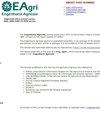OPTIMUM WATER RANGE AND LOAD-BEARING CAPACITY IN SOIL MANAGEMENT SYSTEMS, STRAW REMAINING, AND CHISELING IN SUGARCANE
IF 0.8
4区 农林科学
Q3 Agricultural and Biological Sciences
引用次数: 0
Abstract
Sugarcane requires planning aimed at maintaining production levels, technological quality, and longevity of the sugarcane field, as it is a semi-perennial crop. To this end, the adoption of soil management systems associated with the maintenance of remaining straw are some of the strategies aimed at protecting the soil structure and its properties vital to the sustainability of agricultural systems. In this context, this study aimed to evaluate the influence of soil management systems and remaining straw with and without ratoon chiseling on the optimum water range (OWR) and load-bearing capacity (LBC) of the soil. The experimental design consisted of randomized blocks in a split-plot scheme, with four replications. The plots were composed of no-tillage and conventional tillage, the subplots consisted of three levels of remaining straw (0, 50, and 100%), and the sub-subplots consisted of the use or not of chiseling. Samples with preserved structures were collected at depths of 0.05 and 0.15 m for the analysis of the physical indicators OWR and LBC. Maintaining 100% straw associated with the use of chiseling resulted in an increase in OWR in both soil management systems and depths. Maintaining straw at 50 and 100% also led to lower LBC values in the evaluated soil management systems and depths, suggesting an improvement in soil physical quality. The use of chiseling of ratoons in conventional tillage promoted higher LBC values, indicating possible additional soil compaction in these areas.土壤管理系统的最佳水分范围和承载能力,秸秆残留和甘蔗的凿凿
甘蔗是一种半多年生作物,需要以维持生产水平、技术质量和甘蔗田寿命为目标的规划。为此目的,采用与维持剩余秸秆有关的土壤管理系统是一些旨在保护土壤结构及其特性的战略,这对农业系统的可持续性至关重要。在这种背景下,本研究旨在评估土壤管理系统和剩余秸秆的影响,没有截根苗凿开在最优水范围(OWR)和承载能力(LBC)的土壤。实验设计采用分块法随机分组,共4个重复。样地由免耕和常规耕作组成,分样地由剩余秸秆3个水平(0、50%和100%)组成,分样地由是否使用凿凿组成。在0.05和0.15 m深度采集结构保存完好的样品,分析物理指标OWR和LBC。在使用凿凿的同时保持100%的秸秆,增加了土壤管理系统和深度的OWR。将秸秆保持在50%和100%也会降低土壤管理系统和深度的LBC值,表明土壤物理质量得到改善。在常规耕作中使用凿子可以提高LBC值,表明这些地区可能存在额外的土壤压实。
本文章由计算机程序翻译,如有差异,请以英文原文为准。
求助全文
约1分钟内获得全文
求助全文
来源期刊

Engenharia Agricola
Agricultural and Biological Sciences-Agricultural and Biological Sciences (miscellaneous)
CiteScore
1.90
自引率
20.00%
发文量
62
审稿时长
6 months
期刊介绍:
A revista Engenharia Agrícola existe desde 1972 como o principal veículo editorial de caráter técnico-científico da SBEA - Associação Brasileira de Engenharia Agrícola.
Publicar artigos científicos, artigos técnicos e revisões bibliográficas inéditos, fomentando a divulgação do conhecimento prático e científico na área de Engenharia Agrícola.
 求助内容:
求助内容: 应助结果提醒方式:
应助结果提醒方式:


